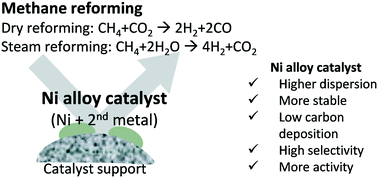Effects of alloying for steam or dry reforming of methane: a review of recent studies
Abstract
Methane is an important chemical resource, not only in natural gas but also in biogas, which can be regarded as a renewable energy resource. Reforming of methane with steam or carbon dioxide, which is important for producing hydrogen and syngas, is conducted at high temperatures using heterogeneous catalysts. To achieve high activity, stability, and low carbon deposition, many studies have been conducted in recent years on the use of alloys as active sites in these catalysts. This review presents a summary of recent studies of alloy catalysts, for which various secondary metals have been added to active metals, such as Ni. Then we summarize the current status of these alloys in terms of their structure, electronic state, and adsorption. The reported effects of alloying include improvement of dispersion and reducibility of the supported metal, change in catalytic performance such as activity and selectivity, and improvement of durability against carbon deposition, sulphur poisoning, and sintering. The directions of future research and development are summarized in terms of sulphur resistance, sintering inhibition, and high activity at low temperatures.



 Please wait while we load your content...
Please wait while we load your content...